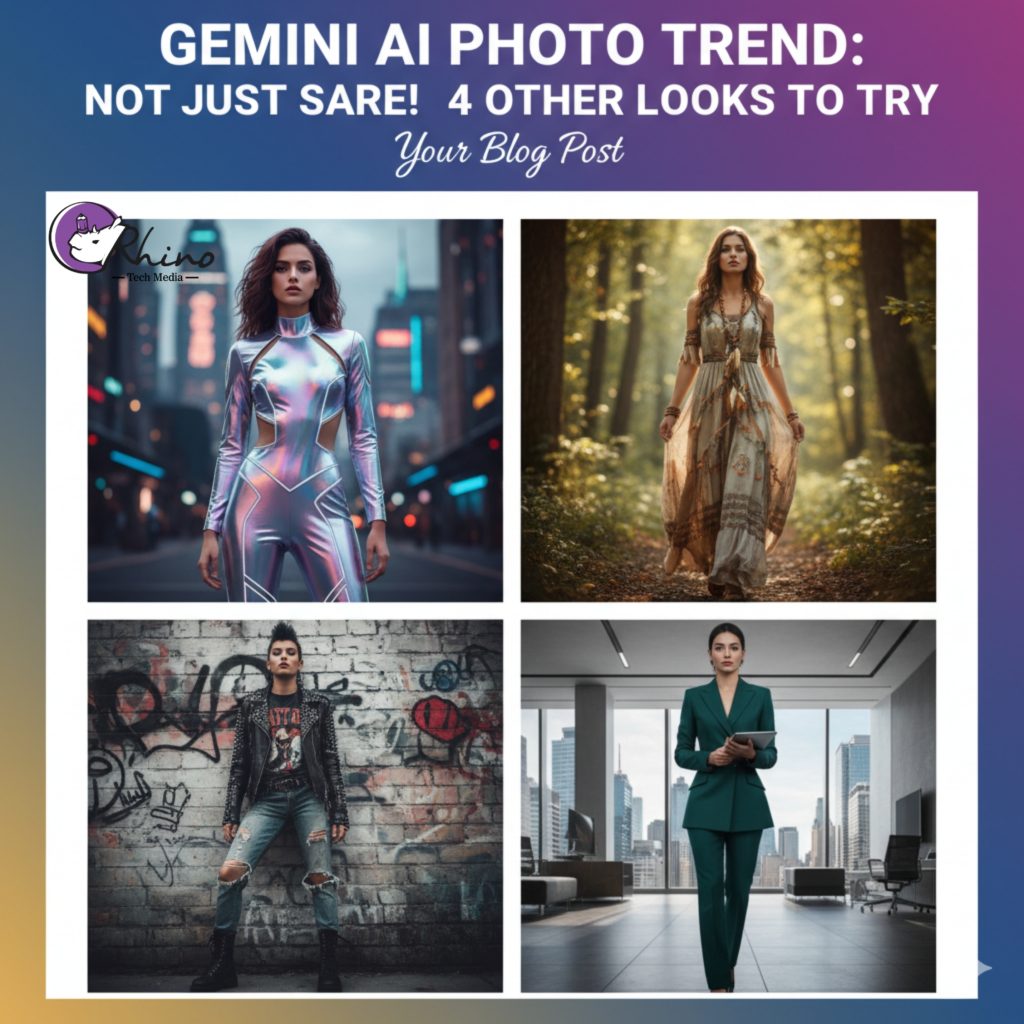The Spark: Retro Saree Edits
Over the past week or so, social media has been abuzz with the Gemini Nano Banana tool (part of Google Gemini). Users upload selfies and use AI prompts to transform themselves into dreamy, vintage Bollywood–style images. The classic caption: flowing chiffon or Banarasi sarees, golden hour or sunset lighting, grainy “film textures,” sometimes wind in the drape, floral accents, moody expression.
The appeal is a mix of nostalgia + cinematic aesthetic + fashion. Sarees, being emblematic of Indian tradition but also cinematic glam, provide a visually rich canvas for AI stylization. The AI preserves your face while changing outfit, background, lighting etc., so people feel they’re starring in their own retro poster.
However, as with most viral AI trends, there are concerns (privacy, image fidelity etc.), but that’s another discussion.
Four Other Looks to Try
While the saree look is dominating, there are other aesthetic directions the AI tools are enabling. Here are four alternative styles that are trending or promising, for people who want variety or want to stand out.
1. Traditional / Regional Outfits
Instead of the pan-Indian retro saree, you can use the AI to transform into more regionally distinct or classically traditional Indian outfits. Examples include:
- Lehenga Choli: Festive, ornate, with embroidered skirts and matching choli. Good for wedding mood or celebration.
- Anarkali Dress: Flowing, layered, regal. Specifies dreamy vibes, colours, textures.
- Sherwani / Kurta-Pyjama (for men or gender-neutral): Traditional male / unisex styles with rich fabrics, patterns, embroidery etc. This gives a majestic or formal look.
These looks lean more into heritage, giving an alternative to the saree while maintaining cultural authenticity.
2. Bollywood / Red Carpet Glamour
If retro saree edits are your entry into cinematic style, you might level up into more “glamour” modes. These include:
- Red carpet look: Big dramatic lighting, premium fabrics, gowns or designer-style outfits, bold makeup, glam hair, etc.
- Iconic Film Looks: Recreate looks from famous movies (costume, hairstyle, setting). For example, “Jodha Akbar” royalty, or “Kabhi Khushi Kabhie Gham” family glamour, etc. These carry inherent high visual impact.
These promise a bit more polished, high-fashion risk, for those who want more drama.
3. Fusion / Boho Styles
For those who want something less formal, more playful or modern, fusion styles are a great route. These styles combine elements of Indian tradition with Western or contemporary aesthetics.
- Indo-Western: e.g. kurta with jeans, mixing traditional prints with modern cuts or accessories.
- Boho: Flowy fabrics, earthy or pastel tones, minimal yet expressive accessories (bracelets, anklets, feather or beaded jewellery), natural settings perhaps (fields, gardens). Gives a free-spirited vibe.
These styles allow for more individual expression and less “costume” feeling.
4. Regional / Heritage Looks
Another strong direction is to emphasize specific regional identities, heritage styles, and localized aesthetic details. This can include:
- Outfits and ornamentation specific to Rajasthan (e.g. ghagra, mirror work, jewellery, bright colours).
- Gujarat / Kutch, Punjab, etc., bringing in local textile patterns, traditional jewellery, turbans (for male or mixed gender styles), etc.
- Heritage backdrops or architectural settings matching the region; this can increase the authenticity and visual richness.
These edits can carry both personal meaning (for people from those regions) and stand out because they’re visually distinctive.
Why These Alternatives Matter
Exploring these other looks is valuable for several reasons:
- Uniqueness: When everyone is doing the “vintage saree” look, these alternatives help you stand out.
- Personal identity and representation: Different people connect with different styles—regional wear or fusion might feel more “you” than a retro saree.
- Creative freedom: AI tools allow quick iteration—so trying different styles teaches what aesthetic you prefer, what works in your pictures.
- Avoiding saturation: As more people do the same look, its novelty declines; branching out keeps things fresh.
Tips / How to Pull These Looks Off
- Be specific in your prompt: outfit style (fabric, colour, cut), accessories, background, lighting, mood.
- Maintain your facial identity: often what makes these look good is the AI is asked not to distort the face, so you still recognise yourself.
- Good input photo: clear, well-lit, minimal distracting background. Higher resolution gives better results.
- Combine style + context: e.g. heritage style works better with relevant background textures (old walls, ornate doors, cultural setting).
- Try variations: small changes (colour, fabric type, poses) can make big visual difference.
Challenges / Risks
- Overused or cliche: Some of these styles may become next “saturated” trends.
- Authenticity vs stereotyping: When recreating regional or traditional styles, there’s a chance of oversimplification or stereotyping.
- AI biases / distortions: Sometimes the AI misrenders fabrics, skin tones, jewellery etc.
- Privacy & image ownership: As with the saree trend, people have reported “creepy” details appearing or concerns about how images are used.
Conclusion
The Gemini Nano Banana saree edits are capturing imaginations by blending Indian tradition, cinematic nostalgia, and visual drama. But there are rich opportunities beyond sarees: lehengas, Anarkalis, sherwanis; Bollywood red carpet glamour; fusion and boho; regional heritage styles. For users, trying these alternatives can refresh your social-media aesthetic, showcase different parts of your identity, and leverage AI creatively without just following the crowd.

